|
Nail fungus is a common condition that begins as a white
or yellow spot under the tip of your fingernail or toenail.
As the fungal infection goes deeper, nail fungus may cause
your nail to discolor, thicken and crumble at the edge.
It can affect several nails.
If your nail fungus is painful and has caused thickened
nails, self-care steps and medications may help. But even
if treatment is successful, nail fungus often comes back.

"What
happens if you do not treat fungus?
Treating
fungus is not the same as treating
a cold or an acute respiratory infection, which
we
are
trying
to cure with common remedies. Fungus is a dangerous
enemy to our body. During a person's lifetime, it
produces toxins, that can decrease one's immunity,
and which can lead to disorders of internal organs,
as well as severe allergic reactions .
In
people over 40, fungus infection represents one
of the main causes for recurring colds, bronchial
asthma, disorders in the functioning of the internal
organs. At this age, toenail infection may cause
dermatitis on the entire calf. That's why treating
the fungus quickly is imperiously necessary. Neglecting
the disease can lead to total dystrophic onychomycosis,
that may cause life-threatening complications.
And
now, the most important aspectů
During
a lifetime, fungus produces toxic elements: These
toxins, once in the body, may cause severe
disorders.

A
high %
of the cases lead to death
If
you do not take measures in the early stages of
the infection, the fungus, along with the blood,
spreads all the way through the internal organs
and due to a low immunity, causes the development
of
infectious complications: toxic-allergic damage
of the heart, liver, organs ,the abdominal
cavity, kidneys etc.
If
the right measures are not taken in the early stages,
in a couple of years it will also completely destroy
the nail plate structure and eventually it will
be lost. "
Melvin
Lim MD
When should
I call the doctor?
"In some cases, toenail fungus can cause an infection
called cellulitis. Without prompt treatment, cellulitis
may pose a serious danger to your health.
You should seek treatment guidance from a trusted
healthcare provider if you have:
Circulation problems.
Diabetes.
Redness, pain or pus near the toenail.
Weakened immune system "
Source Cleveland Clinic
|

Nail fungus is also called onychomycosis (on-ih-koh-my-KOH-sis).
| "Foot pain. Over time, a nail infected with fungus
can become thick and misshapen, causing pain, Dr. Joseph
says. It can even make it difficult to walk when wearing
shoes, according to the American Podiatric Medical Association.
Spread of the fungus. Sometimes untreated toenail
fungus can spread to the surrounding skin on the foot.
This may result in athlete’s foot, a condition
marked by itchy, red, cracked skin. “If you wear
shoes and socks all day and one of your toenails is
infected, it can spread quite easily because fungus
thrives in a warm, dark, moist environment,” Joseph
says. The fungus can also spread to the genitals, where
it becomes jock itch, a condition that can affect both
men and women, according to the American Osteopathic
College of Dermatology." |
Some examples of the most common forms
of onychomycosis:

You are not alone
It is estimated that over 10% of the population suffers
from onychomycosis. That means approximately 6.3 million
people in the UK have this problem, right now. And for
most, it’s an unsightly secret that slowly gets worse
and worse, spreading across toes or fingers and of course,
to other family members. Source
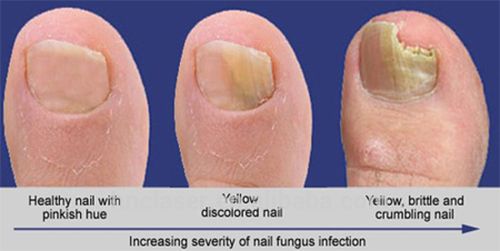
Causes
Fungal nail infections are caused by various fungal organisms
(fungi). The most common cause is a type of fungus called
dermatophyte. Yeast and molds also can cause nail infections.
"Research done by PinPointe, which is based
in Chico, Calif., identified more than 100 organisms,
including
fungi, yeast, mold and bacteria, that work together to
cause toenail fungus." |
Fungal nail infection can develop in people at any age,
but it's more common in older adults. As the nail ages, it
can become brittle and dry. The resulting cracks in the nails
allow fungi to enter. Other factors — such as reduced
blood circulation to the feet and a weakened immune system — also
may play a role.
LYME
DISEASE& FREQUENCY
Toenail fungal infection can start from athlete's foot (foot
fungus), and it can spread from one nail to another. But
it is uncommon to get an infection from someone else. Source
Before And After

"In one small study about laser treatment for toenail
fungus, which appeared last year in the Journal of the
American Podiatric Medical Association, “26 eligible
toes (ten mild, seven moderate, and nine severe)” were
treated with a laser produced by Nomir Medical Technologies,
which is still seeking FDA approval. After six months,
85 percent of the toenails had improved." |
According to the American Academy of Dermatology
"It’s easy to get a fungal nail infection. If
you have a fungal infection on your foot, the fungus can
spread to
one or more of your nails. This is quite common.
You can also catch a fungal nail infection in a warm, moist
place like a pool deck or locker room. If someone else has
a fungal infection and walked barefoot there, all you have
to do is walk barefoot in the same area.
Having wet nails for a long time can also lead to nail fungus.
Some people develop it when they wear the same pair of sweaty
shoes or boots every day. Fingernails that are wet for hours
at a time due to a job or hobby are also susceptible. "
Treatment can prevent the infection from
causing more damage to your nails.
If you have diabetes or a weakened
immune system, treatment is especially important.
After getting a
fungal nail
infection, people who have diabetes have an increased
risk of developing sores that do not heal. Sores that
do not heal can lead to a serious health problem. It’s
important to see a dermatologist (or other doctor)
at the first sign of a nail problem. |
"Fungal nail infections
further complications. , if the infection is left
untreated, it may cause pain and discomfort. In toenails,
this can eventually lead to difficulty wearing shoes and
walking. In fingernails, this could cause difficulty
writing. If the infection spreads to the skin around the
nail, it can result in cellulitis (bacterial infection under
the skin)
or osteomyelitis (infection of the bone). These complications
more commonly occur among older people and people with health
conditions."
"The elderly are more likely to have
toenail fungus than younger people because they have
had more years
to be exposed to the infection and their immune systems
can’t always fight it off, according to Washington
podiatrist Lee Firestone. He estimates that about half
of people over 70 have toenail fungus." |
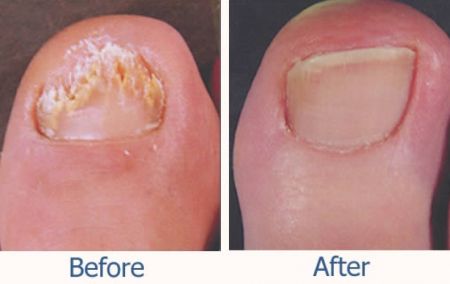
Pre-Existing Medical Conditions
"If you have pre-existing health conditions, a toenail fungus
can lead to serious complications. One of the most common
health conditions associated with toenail fungus and its
dangers is diabetes.
When you have diabetes or any other condition that can weaken
the immune system, it’s so important to treat a toenail
fungus immediately. Because of a compromised immune system,
you run the risk of the fungus spreading. If it’s able
to do that, other parts of your body can easily become infected.
“Podiatrists frequently cite this as a cause
of diabetic amputations,” Dr. Elewski said. “The
fungus paves the way for bacteria, and it can definitely
be a problem.”Source |
If you do have a pre-existing condition with a weakened
immune system, allowing a toenail fungus to spread
can fuel other health complications. While the fungus itself may not
be the cause of the health issues, it’s a great catalyst
to fuel the symptoms that can come with many types of conditions"
"Richard, a retiree in Fairfax
who did not want his full name associated with toenail
fungus, got a laser
treatment on all 10 toes in April 2010, and he says
his nails were fully cleared of the yellowed, thickened
look
after a year. " |
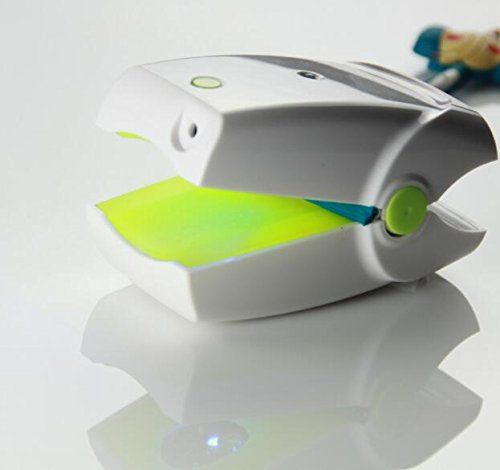
"If the infection does spread and gets into exposed areas
of the skin, it can seep into your bloodstream, and become
deadly. If you notice your toenail fungus spreading at all,
with blistering, cracking skin, see your doctor about antibiotics
for the infection as soon as possible."
"What
are the possible side effects of terbinafine (Lamisil)
Oral antifungal drugs?
"Terbinafine is an antifungal
antibiotic.
Terbinafine is used to treat infections caused by
fungus that affect the fingernails or toenails. Terbinafine
oral granules are used to treat a fungal infection
of scalp hair follicles in children who are at least
4 years old."
"Oral antifungal drugs may cause
side effects ranging from skin rash to liver damage.
You may need
occasional
blood tests to check on how you're doing with these
types of drugs. Doctors may not recommend them for
people with
liver disease or congestive heart failure or those
taking certain medications." Source
"Get emergency medical help if you
have any of these signs of an allergic reaction:
hives; difficulty breathing;
swelling of your face, lips, tongue, or throat. Call your
doctor at once if you have symptoms of liver damage," Source |
“The problem is huge. It is bigger than you can imagine,” says
Washington podiatrist Stephen J. Kominsky. “I would
say 70 percent of the patients who come into my office have
fungal infections on their toenails.”
There may be hope. Podiatrists have begun using a laser
treatment that combats the infection
The treatment, in which the podiatrist aims a laser beam
at the patient’s toenails to kill the organisms that
cause the fungus, costs about $1,000 and is not covered by insurance because it is considered an aesthetic procedure. The nails aren’t immediately
clear after the treatment, which takes up to an hour; the patient must wait for the
fungus-free nails to grow out.

Last year, the Food and Drug
Administration cleared the first laser, for “temporary increase
of clear nail” in patients with onychomycosis,
the medical term for a fungal infection of the nail.
The FDA cleared a second one, in April. |
The best way to avoid other health issues when you have
a toenail fungus is to treat the fungus as soon as possible.
Home Use Laser Treatment of Fungal Nail Disease 905nm laser
with 465nm blue light
HNC 905nm laser therapy device to treat nail fungal infections
(Onychomycosis, which combines pulse laser radiation and blue
light energy, resulting in a synergetic therapeutic effect.
Kominsky has treated 400 to 500
patients with the laser. Compared with oral medication,
he says, “the
odds of success are better with the laser; plus, there’s
no side effects.” |

How a Lasers Works
"The laser is a concentrated beam of light energy that vaporizes
tissue in the area of treatment, according to Toenail Fungal
Treatments. Different wavelengths of energy are used in order
to selectively treat different body areas. The fungus is
targeted and destroyed by the laser, allowing the nail and
surrounding skin to remain intact. The laser beams heats
the fungus, killing it, without affecting the surrounding
tissue. Studies have shown promising results."
Treatment Procedure and Costs
The treatment can be performed in the office and
takes approximately 20 minutes. Three separate visits
may be required, according to Dr. Marc Katz, a podiatrist
practicing in Tampa, Fla. The laser beam operates
at two separate wavelengths to destroy any pathogens.
No anesthesia is required to perform the procedure.
To date, this procedure is not covered by medical
insurance and can be expensive. Toenail fungus is
considered to be a cosmetic disease. Laser treatment
can cost $1,000 to $2,500 and must be paid by the
patient.
Now you can treat yourself at home
for under $US200.00 |
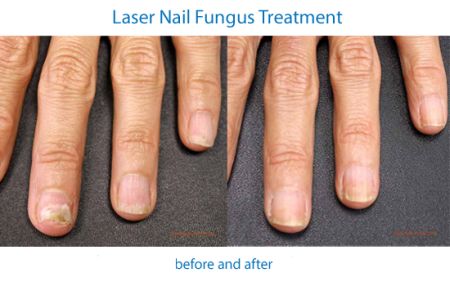
Laser irradiation will penetrate the infected nail plate
and will target causative pathogens residing on the nail
bed. As a result, the infection will be greatly alleviated
and gradually eliminated.
"According to Park Plaza Foot Specialists of Houston, the
laser procedure is not painful. It reports no health or age
restrictions for having laser treatment performed on fungal
toenails. It says there have been no clinical reports of
any side effects or adverse reactions, and that shoes and
nail polish can be worn directly following treatment. "

Fungus Free
FAQ:
1. What will i feel during treatment?
People will usually feel nothing. In rare cases some may
feel a slight warming effect.
2. When will nail health improvement be evident?
Treatment duration may vary between individuals, depending
on variables such as age, severity of infections and so on,
Estimated treatment duration is 3-6 months.
3. Can the laser burn me?
No,
it’s Class 1M laser device, no reported burnings
:)
Clinic test approved:
Laser treatment consisted of four sessions with one week
interval, during which all infected nails were irradiated
three times with laser light so that the nail plate was fully
covered each time.

The procedure is simple and quick with no noticeable side
effects and complications.
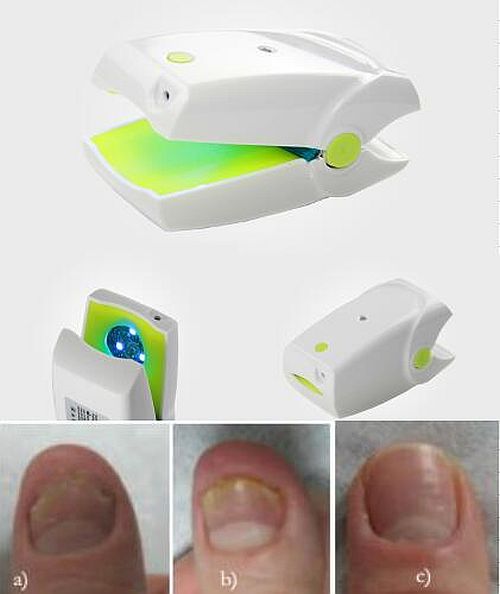 |
Home
Laser Treatment of Fungal Nail Disease
Nail laser unit
905nm laser with 465nm blue light
Non invasive treatment
No known side effects
Painless
Easy to Use
Compact and portable
Fully Rechargeable
Charger pack
Operation Instructions:
1). Place the device on the infected nail and press
the operating button.
2). Treatment light will begin
to blink and the device will emit visible blue light.
3).
The device will operate for 7 Min and shut off automatically.
|
Source https://www.washingtonpost.com
|

